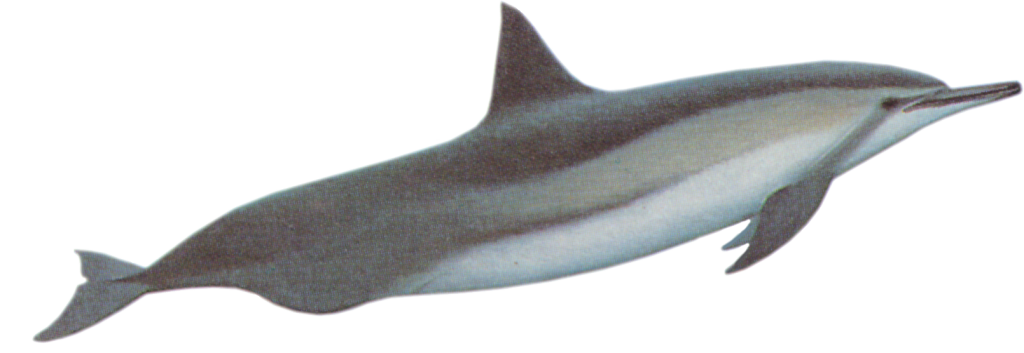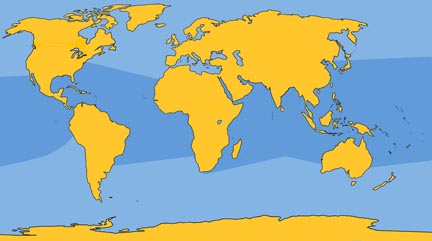
Family: Delphinidae
Genus: Stenella
Species: S. longirostris (Gray, 1828)
Taxonomic Note: There are a wide variety of spinner dolphins, all but one (Short-snouted spinner dolphin) are currently classified as Stenella longirostris. Although these varieties are not recognized as separate species, they have been given popular common names by researchers working closely with the given populations. Below are the indicated common names with variant descriptions, based on contemporary and ongoing research.
One of the more delicate-looking Stenellas, the spinner dolphin has a long, graceful beak and a petite overall appearance. The animal can be identified at sea by its practice of leaping and spinning as it swims. Whether this behavior is as playful and frivolous as it appears or has a serious biological purpose, remains to be determined.
Spinners of the eastern tropical Pacific Ocean associate with schools of yellowfin tuna, a relationship that has led to their being killed by the millions during purse seine tuna fishing operations of at least the past four decades.
As discussed in the taxonomic note, spinners are bunched into one distinct species, Stenella longirostris, although there are dramatic variations among geographic populations.
Whereas sexual dimorphism does not occur in many species of the cetaceans, certain eastern tropical Pacific Ocean spinner herds do have obvious physical distinctions between females and males. Males possess a bump, or protuberance, on the ventral peduncle, and a forward cant to the dorsal fin that to the casual observer may make it appear as though the fin were placed on backward. Although there are theories concerning the presence of the protuberance and dorsal fin cant, none has yet to be proven. One guess seems to be that it allows females of one population to find males of the same population in conditions when herds are mixed.
Spinners may dive as deep as 200 ft (61 m) to feed. Calves are born at an estimated 32 in (80 cm) in length, and little else is known of its breeding habits. Almost nothing is known of their migratory habits.
Costa Rican Spinner Dolphin: Also called the long-snouted dolphin, this animal has a long, slender body, with an elongated and delicate rostrum. They are dark gray dorsally, with a lighter color on the ventral region. The dorsal fin is tall, triangular, and canted toward the front in older males. The flippers are long, thin, and pointed at the tips. Costa Rican spinner dolphins are from 5.6 to 7 ft (1.7 to 2.1 m) in length and weigh an estimated 150 lb (68 kg). There are an estimated 100 small, conical teeth in the upper and lower jaws. The known diet includes small fish and copepods. These dolphins herd in numbers of 1,000 or more and are found near the coast of Nicaragua, Costa Rica, and Panama.
Eastern Spinner Dolphin: Like the Costa Rican spinner, this animal is also known as the long-snouted dolphin. It has a short, slender body with a short heavy rostrum. This dolphin is similar in color to the Costa Rican spinner dolphin, although it has the darkest dorsal region of all spinners. The flippers and fins are similar to those of the Costa Rican spinner. The ventral keel past the anal region displays a protuberance comprised of connective tissue which corresponds in size to the degree of forward cant of the dorsal fin. The length varies from 5.5 to 6 ft (1.65 to 1.8 m); weight averages 135 lb (61 kg). The eastern spinner has the same basic tooth count as the Costa Rican spinner. Gestation is believed to be 10.6 months. These dolphins are found in herds of 1,000 or more, often mixed in with Pacific spotted dolphins. They are found along the coast of Mexico, extending out 1,200 mi (1,900 km).
Whitebelly Spinner Dolphin: This dolphin, too, is often called the long-snouted dolphin. It has a short stocky body, dark, down to the eye level on the dorsal side. The ventral region is white. The dorsal fin may be triangular or falcate; a slight protuberance is present along the ventral keel. Small, thin flippers are pointed at the tips. The average whitebelly spinner length is 5.75 ft (1.75 m); average weight, 135 lb (61 kg). The diet consists of small fish and copepods. The gestation is believed to be 10.6 months. They herd in numbers of 1,000 or more and are often found with Pacific spotted dolphins. Whitebelly spinners are found in offshore Pacific waters of Mexico, Central America, and the Pacific side of northern Central America, extending out nearly 200 mi (322 km), and overlapping the range of the eastern spinner.
Tropical Atlantic and Indian Ocean Spinner Dolphin: These animals also have a long snout, and the two geographic herds are similar if not identical, and the length of the beak may vary with individual animals of herds of different regions. These animals are dark gray dorsally, lighter on the flanks, and white on the ventral region. The tip of the rostrum and the lips are black. The dorsal fin is smaller than that of the eastern tropical Pacific animals and is falcate. The flippers are long and pointed. These dolphins reach a length of 6 to 7 ft (1.8 to 2.1 m) and weigh an estimated 180 lb (82 kg). There are from 92 to 130 small, conical teeth in each of the upper and lower jaws. The known diet includes small fish and copepods. These animals herd in numbers of several hundred or more and are distributed throughout the tropical Atlantic, the Gulf of Mexico, and most of the Indian Ocean.
Hawaiian Spinner Dolphin: These animals were previously referred to taxonomically as Stenella roseiventris, a streamlined dolphin with a long, thin rostrum. They have a distinct three-toned color pattern. The area from the rostrum to just past the dorsal fin is gray, the flanks are a lighter color, and the ventral region is white. The dorsal fin is falcate but smaller than those of the Pacific spinners. The flippers are long, thin, and pointed at the tips. These dolphins reach a length of up to 7 ft (2.1 m) and a weight of 200 lb (91 kg). There are 100 small, conical teeth in the upper and lower jaws. The diet includes small fish. Hawaiian spinners herd in numbers of about 200 usually and often are found with humpback whales when the larger animals migrate to Hawaiian waters during the winter. Thee spinners are found readily in Hawaiian waters and have been reported as far east as San Diego, California.







